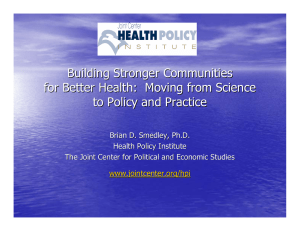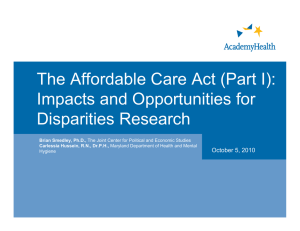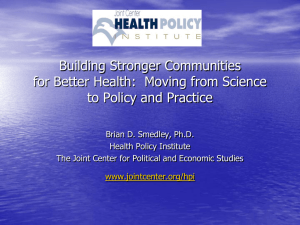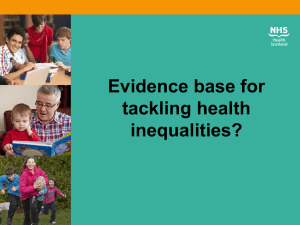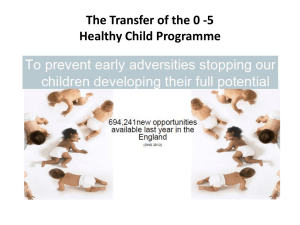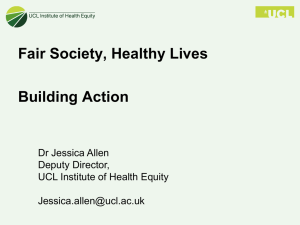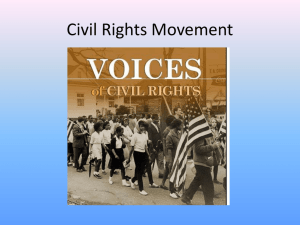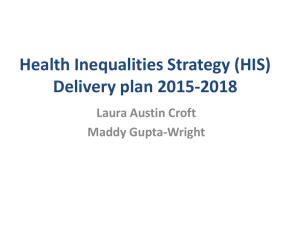pptx - Minority Health Project
advertisement
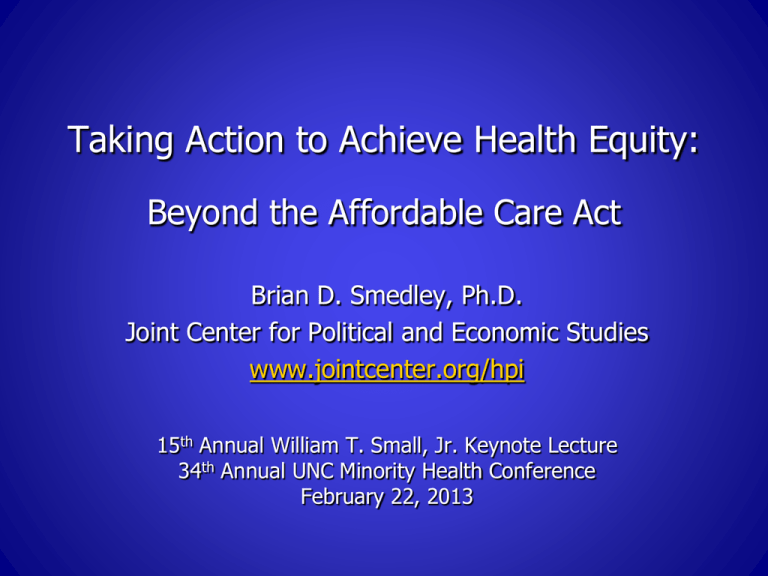
Taking Action to Achieve Health Equity: Beyond the Affordable Care Act Brian D. Smedley, Ph.D. Joint Center for Political and Economic Studies www.jointcenter.org/hpi 15th Annual William T. Small, Jr. Keynote Lecture 34th Annual UNC Minority Health Conference February 22, 2013 Examples of Racial/Ethnic Health Inequalities • Many racial and ethnic minority groups – particularly American Indians, African Americans, Pacific Islanders, and some Asian Americans and Latinos – have higher rates of disease and disability than national averages • African Americans and American Indians have high rates of infant mortality, even when socioeconomic differences are taken into account • African Americans, American Indians, and other experience high rates of premature mortality Change Over Time in Racial and Ethnic Disparities for Selected Core Health Care Access Measures, 2002-2003 to 2007-2008 AHRQ, National Healthcare Disparities Report, 2011 100% 90% 80% 70% 60% 50% 40% 30% 20% 10% 0% 1 1 11 1 1 2 6 12 9 11 Improving Same 3 2 2 4 0 Black vs. Asian vs. AI/AN vs Hispanic Poor vs. White White White vs. NH High (n=17) (n=17) (n=17) White Income (n=17) (n=20) Worsening Examples of Health Care Quality Gaps AHRQ, National Healthcare Disparities Report, 2008 • African Americans have higher rates of hospital admissions for lower extremity amputations than whites • Asian Americans are less likely than Whites to get care for an injury or illness as soon as wanted • American Indian and Alaska Native women are twice as likely as whites to lack prenatal care • Parents of Hispanic children are twice as likely as whites to report problems communicating with health care providers The Economic Burden of Health Inequalities in the United States (www.jointcenter.org/hpi) • Direct medical costs of health inequalities • Indirect costs of health inequalities • Costs of premature death The Economic Burden of Health Inequalities in the United States • Between 2003 and 2006, 30.6% of direct medical care expenditures for African Americans, Asians, and Hispanics were excess costs due to health inequalities. • Eliminating health inequalities for minorities would have reduced direct medical care expenditures by $229.4 billion for the years 2003-2006. • Between 2003 and 2006 the combined costs of health inequalities and premature death were $1.24 trillion. Patient Protection and Affordable Care Act of 2010: Addressing Health Equity for Racially and Ethnically Diverse Populations www.jointcenter.org/hpi Implications of PPACA for Addressing Health Inequalities in the United States Insurance coverage expansions • Expand Medicaid income eligibility to 133% of FPL (some states have set eligibility well below 20% of FPL). • Employers with 50 or more employees must offer coverage or pay a penalty for FTEs receiving tax credit to purchase insurance. • Small employers with fewer than 25 employees are eligible for tax credit to purchase insurance (among workers in small firms, 57% of Hispanics, 40% of African Americans, 40% of American Indians, and 36% of Asian Americans are uninsured). Implications of PPACA for Addressing Health Inequalities in the United States (continued) Improving Access to Health Care: • Doubles funding to expand Community Health Centers. • Funds to expand oral and behavioral health care services in CHCs. • Expands funding for National Health Service Corps. • Increases Medicaid payments for primary care services to 100% of Medicare payment rates for 2013 and 2014. • Authorizes funds for school-based health centers, nursemanaged health clinics, and Community Health Teams to support medical homes Implications of PPACA for Addressing Health Inequalities in the United States (continued) Data Collection and Reporting • Require that population surveys collect and report data on race, ethnicity and primary language • Collect and report disparities in Medicaid and CHIP • Monitor health disparities trends in federally-funded programs Implications of PPACA for Addressing Health Inequalities in the United States (continued) Other Important Provisions: • Reauthorizes Titles VII and VIII, health workforce • • • programs to increase diversity and improve the distribution of providers Authorizes cultural competence education and organizational support Increases investments in health disparities research Establishes Prevention and Public Health Fund More Needs to Be Done: Despite the Important Provisions in PPACA, Public Health and Health Systems in Partnership with Communities Can Take Steps to Address Root Causes of Health Inequities What Factors Contribute to Racial and Ethnic Health Disparities? • Socioeconomic position • Residential segregation and environmental living • • • • conditions Occupational risks and exposures Health risk and health-seeking behaviors Differences in access to health care Differences in health care quality Structural inequality – including historic and contemporary racism and discrimination – influences all of the above The Role of Segregation Racial Residential Segregation – Apartheidera South Africa (1991) and the US (2010) Source: Massey 2004; Iceland et al 2002; Glaeser and Vigitor 2011 100 95 Segregation Index 90 85 80 75 70 65 60 55 50 South Africa Detroit Milwaukee New York Chicago Newark Cleveland United States Negative Effects of Segregation on Health and Human Development • Racial segregation concentrates poverty and excludes and isolates communities of color from the mainstream resources needed for success. African Americans are more likely to reside in poorer neighborhoods regardless of income level. • Segregation also restricts socio-economic opportunity by channeling non-whites into neighborhoods with poorer public schools, fewer employment opportunities, and smaller returns on real estate. Negative Effects of Segregation on Health and Human Development (cont’d) • African Americans are five times less likely than whites to live in census tracts with supermarkets, and are more likely to live in communities with a high percentage of fast-food outlets, liquor stores and convenience stores • Black and Latino neighborhoods also have fewer parks and green spaces than white neighborhoods, and fewer safe places to walk, jog, bike or play, including fewer gyms, recreational centers and swimming pools Negative Effects of Segregation on Health and Human Development (cont’d) • Low-income communities and communities of color are more likely to be exposed to environmental hazards. For example, 56% of residents in neighborhoods with commercial hazardous waste facilities are people of color even though they comprise less than 30% of the U.S. population • The “Poverty Tax:” Residents of poor communities pay more for the exact same consumer products than those in higher income neighborhoods– more for auto loans, furniture, appliances, bank fees, and even groceries Major Findings – Segregated Spaces, Risky Places • For both blacks and Hispanics, residential segregation declined slightly between 2000 and 2010. However, the United States remains a highly segregated country; • Segregation continues to be a predictor of health disparities between blacks and whites and between Hispanics and whites, as measured by infant mortality rates; and • Although segregation is declining, the relationship between segregation and infant mortality disparities appears to have intensified. Trends in Poverty Concentration Steady rise in people in medium, high-poverty neighborhoods 2000s: Population soars in extreme-poverty neighborhoods Blacks, Hispanics, Amer. Indians overconcentrated in high-poverty tracts Most poor blacks, Hispanics live in medium- and high-poverty tracts Metro Detroit: Poverty Concentration of Neighborhoods of All Children Source: Diversitydata.org, 2011 100 90 80 Black 70 Hispanic 60 50 White 40 30 Asian/Pacific Islander 20 10 0 0%-20% 20%-40% Over 40% Metro Detroit: Poverty Concentration of Neighborhoods of Poor Children Source: Diversitydata.org 100 90 80 Black 70 Hispanic 60 50 White 40 30 Asian/Pacific Islander 20 10 0 0%-20% 20%-40% 40% + Science to Policy and Practice—What Does the Evidence Suggest? • A focus on prevention, particularly on the conditions in which people live, work, play, and study • Multiple strategies across sectors • Sustained investment and a long-term policy agenda Science to Policy and Practice – What Does the Evidence Suggest? • Place-based Strategies: Investments in Communities • People-based Strategies: Investing in Early Childhood Education and Increasing Housing Mobility Options Create Healthier Communities: • Improve food and nutritional options through incentives for Farmer’s Markers and grocery stores, and regulation of fast food and liquor stores • Structure land use and zoning policy to reduce the concentration of health risks • Institute Health Impact Assessments to determine the public health consequences of any new housing, transportation, labor, education policies Improve the Physical Environment of Communities: • Improve air quality (e.g., by relocating bus depots further from homes and schools) • Expand the availability of open space (e.g., encourage exercise- and pedestrian-friendly communities) • Address disproportionate environmental impacts (e.g., encourage Brownfields redevelopment) Expanding Housing Mobility Options: Moving To Opportunity (MTO) • U.S. Department of Housing and Urban Development (HUD) launched MTO demonstration in 1994 in five cities: Baltimore, Boston, Chicago, Los Angeles, and New York. • MTO targeted families living in some of the nation’s poorest, highest-crime communities and used housing subsidies to offer them a chance to move to lower-poverty neighborhoods. • Findings from the follow up Three-City Study of MTO, in 2004 and 2005, answer some questions but also highlight the complexity of the MTO experience and the limitations of a relocation-only strategy. • Away from concentrated poverty, would families fare better in terms of physical and mental health, risky sexual behavior and delinquency? Adolescent girls benefited from moving out of high poverty more than boys. Examples of Federal Initiatives • Promise Neighborhoods ($210 million) attempt to bring the innovative • • • ideas of the Harlem Children’s Zone into communities across the country. By simultaneously focusing on the myriad needs of young children – education, health, mentorship, etc. – Promise Neighborhoods can break the cycle of inter-generational poverty and tap the potential of millions of young people. Healthy Food Financing Initiative ($400 million) – would help tackle the dual scourges of joblessness and obesity in underserved communities by helping supermarket operators open new stores, new farmers markets take root, and corner store owners buy the refrigeration units they need to carry fresh food. Choice Neighborhoods ($250 million) – would ensure that housing is linked to school reform, early childhood innovations, and supportive social services, tying housing developments to a range of services and supports leads to improved economic well-being for families. Sustainable Communities Initiative ($150 million) – a joint effort by HUD, the Department of Transportation, and the EPA – is designed to "improve access to affordable housing more transportation options, and lower transportation costs while protecting the environment in communities nationwide." Moving from Science to Practice – The Joint Center PLACE MATTERS Initiative Objectives: Build the capacity of local leaders to address the social and economic conditions that shape health; Engage communities to increase their collective capacity to identify and advocate for community-based strategies to address health disparities; Support and inform efforts to establish data-driven strategies and data-based outcomes to measure progress; and Establish a national learning community of practice to accelerate applications of successful strategies Moving from Science to Practice – The Joint Center PLACE MATTERS Initiative Intersection of Health, Place & Equity Health facilities Access to Healthy Food Schools/ Child care Health Community Safety/ violence Housing Environment Equity Parks/Open Space playgrounds Transportation Traffic patterns Work environments 37 Moving from Science to Practice – The Joint Center PLACE MATTERS Initiative Progress to Date—PLACE MATTERS teams are: Identifying key social determinants and health outcomes that must be addressed at community levels Building multi-sector alliances Engaging policymakers and other key stakeholders Evaluating practices Bernalillo County Life Expectancy by Census Tract 1990 - 2007 New Orleans Life Expectancy by Zip Code 2009 “[I]nequities in health [and] avoidable health inequalities arise because of the circumstances in which people grow, live, work, and age, and the systems put in place to deal with illness. The conditions in which people live and die are, in turn, shaped by political, social, and economic forces.” World Health Organization Commission on the Social Determinants of Health (2008)
